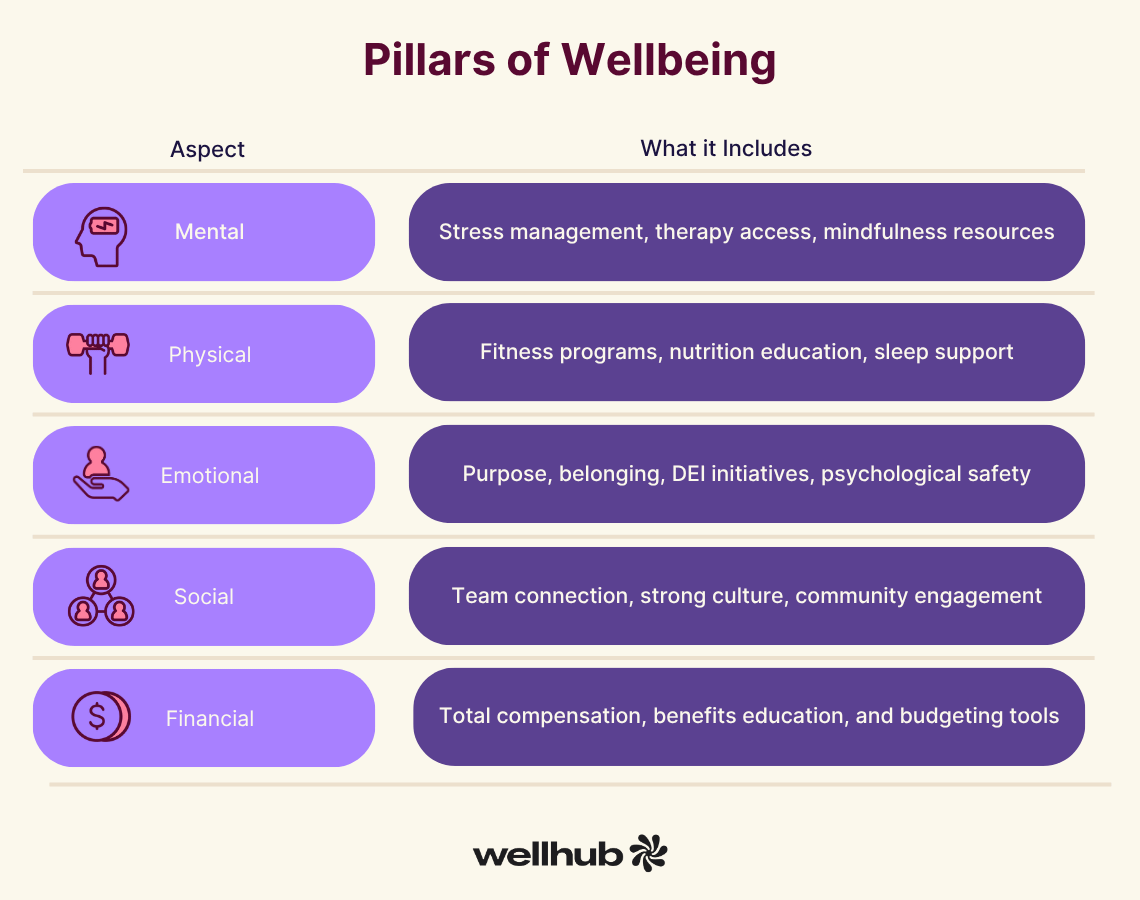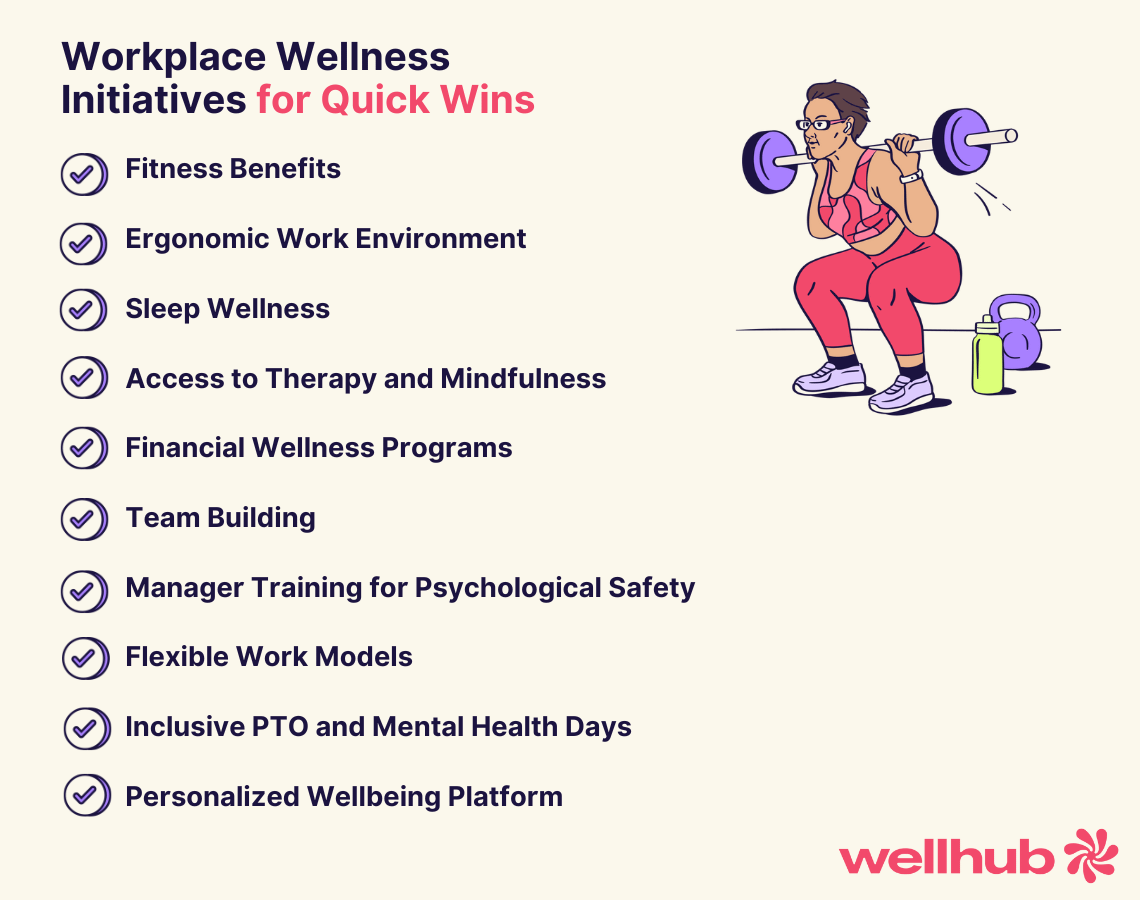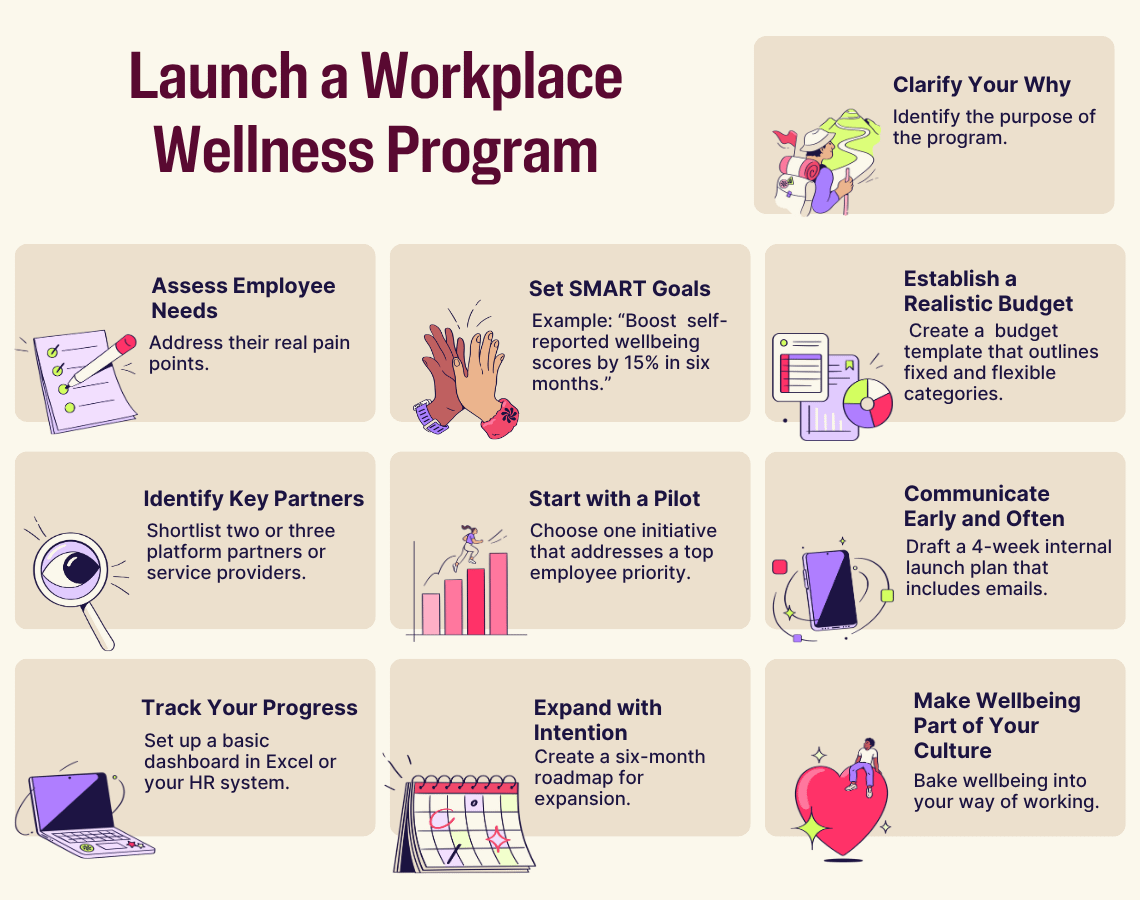10 Easy Ways to Promote Employee Wellbeing in the Workplace
Last Updated Jun 3, 2025

Employees don’t leave stress at the office door.
They carry it home, into their evenings, their families, and their health. When work feels overwhelming or unsupported, wellbeing takes the hit—and so does productivity, retention, and engagement.
For HR leaders, that’s the red flag. But here’s the green light: organizations that invest in whole-person wellbeing don’t just build happier teams. They build stronger businesses. With proven ROI, better recruitment outcomes, and lower absenteeism, workplace wellness isn’t a perk anymore. It’s a strategy.
Uncover the benefits of a full-spectrum wellbeing approach—one that supports your people mentally, physically, emotionally, socially, and financially. It’s time to build a workplace where your people feel good and do great work.

What Is Employee Wellbeing?
Employee wellbeing is the holistic state of how employees feel and function at work and in life—physically, mentally, emotionally, socially, and financially. It’s not just about offering gym discounts or health insurance. It’s about creating the kind of environment where your people can truly thrive.
It’s the outcome you get when your workplace supports the whole person—not just the worker.
The Five Pillars of Employee Wellbeing
To support wellbeing, HR leaders need to think across five key dimensions:

These areas are deeply interconnected. When one declines, others often follow. And when one does improve? It can uplift the whole system.
Why Your Company Should Invest in Workplace Wellness
Let’s zoom out for a second.
Fifty-six percent of companies see more than 100% ROI from their employee wellbeing programs. That means for every dollar invested, they get at least two back. Yes, really.
And organizations that prioritize wellbeing don’t just see internal wins — they actually outperform the stock market. The top companies for employee wellbeing posted a 53% return, compared to 41% for the Nasdaq Composite.
Now here’s the reality many HR leaders are up against: stress is everywhere. In fact, 94% of U.S. employees were already reporting workplace stress back in 2019 — and that number hasn’t exactly gone down. Half of millennials and three-quarters of Gen Z workers have left jobs because of mental stress.
And the pressure doesn’t stop when employees leave the office. Work stress shows up at home too — impacting relationships, routines, and their ability to care for themselves. That makes self-care feel more like a luxury than a daily necessity.
This isn’t just a wellness issue. It’s a workforce issue.
Your people are telling you what they need. And the data backs them up: investing in wellbeing is one of the smartest, highest-impact moves a company can make.
Why? Because wellbeing programs don’t just make people feel better — they help them work better. They drive retention. They reduce healthcare costs. They support mental, physical, and emotional health. And they build cultures where employees actually want to stay.
In short: everybody wins.
Benefit 1: Reduced Absenteeism and Employee Healthcare Costs
Wellbeing is a smart financial strategy. When employees feel well, they show up. Literally. They take fewer sick days, they file fewer insurance claims, and they’re less likely to need expensive, reactive care.
Companies that invest in wellness programs see real, measurable results:
- 91% of HR leaders say their wellbeing program reduces healthcare costs
- 78% report lower medical bills directly tied to wellness investments
- 89% of HR leaders see employees take fewer sick days as a result of their wellbeing program. A full 13% say their wellbeing program reduced the average number of sick days taken by at least five days — that’s a full work week of additional productivity.
For CHROs, this all means fewer claims, fewer sick days, and more stable benefits budgets.
And for employees? It’s the reason they show up healthier, happier, and more prepared to thrive
Benefit 2: Increased Employee Engagement and Retention
When organizations invest in wellbeing, they send a powerful message: We see you. We support you. That kind of support deepens connection to the company’s mission and boosts long-term engagement.
Here’s why that matters: engaged employees are more likely to stick around, contribute more, and grow within the company. Disengaged employees? They're far more likely to burn out or check out.
The data doesn’t lie:
- 98% of HR leaders say their wellbeing program helps reduce turnover
- 55% of employees say they’d consider leaving for a better benefits package
And the gap in satisfaction is striking:
- 61% of employees with wellness programs say they’re happy at their company — compared to just 36% of those without.
When people feel supported in every area of their wellbeing — physical, mentally, financially, and socially — they’re more likely to stay engaged with their work and loyal to their organization. That’s a retention strategy that pays for itself.
Benefit 3: Improved Employee Productivity
Wellbeing and productivity go hand in hand. When people feel well, they don’t just work more. They work better. When employees have the holistic support they need to care for their health, they show up more focused, energized, and ready to do their best work.
And the business case is rock solid.
A study in the Journal of Occupational and Environmental Medicine found that wellness-focused employees saved their companies an average of $353 per person, per year in recovered productivity.
And, as revealed in Wellhub’s Return on Wellbeing 2024:
- 99% of HR leaders say their wellbeing program increases productivity
- 47% say the impact is major
That’s a performance transformation. And that momentum ripples across teams, departments, and the entire business.
Benefit 4: Better Employee Recruitment
Candidates are drawn to companies that care: Nearly 60% of employees say their employer should offer programs that help them stay healthy.
This is especially true for Gen Z and Millennial workers—who seek out employers that will invest in their health and day-to-day employee experience—but it rings for true for the entire workforce at any age:
- 83% of HR leaders saywellness programs are “very” or “extremely” important to talent acquisition
- 89% of job seekers say they’re only considering companies that prioritize wellbeing
Wellness programs strengthen your employer brand and signal a positive culture. They create a workplace where candidates see an opportunity to work at an organization aligned with their values.
10 Initiatives That Can Promote Employee Wellbeing in the Workplace

Physical Wellbeing
- Fitness Benefits
When it comes to supporting employee wellbeing, fitness is one of your strongest tools. Movement isn’t just good for physical health — it boosts mood, sharpens focus, and helps people feel more energized throughout the day.
And here’s the best part: it doesn’t have to be complicated.
Give your team flexible fitness options they’ll actually use. A platform like Wellhub connects employees to thousands of gyms, studios, and fitness apps — so everyone can move in a way that works for them, whether that’s early-morning yoga, lunchtime lifting, or a dance class after dinner.
Want to make movement part of your culture? Try adding:
- Walking meetings or team step challenges
- Daily stretch breaks
- Movement-focused wellness programming in your internal calendar
Even a 10-minute daily routine can deliver major benefits. For added support, consider offering a monthly wellness stipend or subsidizing fitness wearables so employees can track their progress and stay motivated.
Because when fitness is accessible, consistent, and fun, it sticks. And when it sticks, everyone wins.
- Ergonomic Work Environment
Let’s talk posture, performance, and prevention.
Supporting musculoskeletal health doesn’t just help employees feel better in their bodies — it can also reduce injuries, improve focus, and cut down on healthcare costs. That’s a triple win.
Start with the basics: offer ergonomic assessments, either virtually or onsite, to help employees evaluate their workstations. These small adjustments can lead to big improvements.
Next, make it easy for your team to set up for success. Provide ergonomic essentials like:
- Standing desks
- Adjustable chairs
- Monitor risers
- Keyboard trays
For remote and hybrid teams, a home office stipend can go a long way in helping people create healthy, productive spaces.
And don’t stop there — keep healthy habits top of mind by sharing quick-reference posture guides or short videos that encourage daily movement and mindful positioning.
Mental and Emotional Wellbeing
- Sleep Wellness
Sleep is a cornerstone of wellbeing. But the unfortunate reality is 71% of workers say they’re not getting enough rest.
That means most of your team is showing up tired, which can affect everything from mood to productivity to long-term health.
So, what can you do? Start by building a culture that values rest.
Offer flexible scheduling that lets early birds and night owls work when they’re at their best. Host sleep education sessions to cover the essentials, such as how screen time, caffeine, and bedtime routines can make or break a good night’s sleep.
And give your team the tools they need to recharge. Include access to sleep-focused apps like SleepTracker or Calm, and encourage leaders to model healthy boundaries, like truly unplugging after hours.
When your team sleeps better, they feel better. And when they feel better, they do better. It’s really that simple.
- Access to Therapy and Mindfulness
Every employee’s mental wellness journey looks different. That’s why flexible, personalized support is so important, and so impactful.
Start by making sure your healthcare plan includes therapy coverage. Then, expand your reach with trusted partners like Headspace, offering1:1 mental wellness coaching, guided meditations, and stress-reducing tools your team can use anytime, anywhere.
Want to bring mindfulness into the everyday? Try this:
- Host regular guided sessions to help employees reset
- Build a go-to wellness hub with self-guided meditations and breathing exercises
- Weave mindfulness into team culture — even a one-minute grounding exercise at the start of meetings can help everyone show up more present and focused
When you make mental wellness easy to access and simple to practice, your team doesn’t just feel supported — they are supported. And that’s what builds real resilience.
Financial Wellbeing
- Financial Wellness Programs
Financial stress follows employees to work, affecting their focus and ability to be productive. It also gets in the way of self-care: 68% of workers say money worries hold them back from investing in their wellbeing.
That’s why financial wellness deserves a place in your benefits strategy.
Start by offering monthly webinars or lunch-and-learns on key topics like budgeting, debt management, and retirement planning. Make it personal by giving employees access to certified financial planners for one-on-one support — because everyone's financial journey is different.
You can also add tools like EveryDollar to your benefits stack to make budgeting more approachable. And to boost visibility? Weave financial education into onboarding and open enrollment so employees know these resources are there from day one.
When your people feel financially secure, they’re in a stronger position to thrive in every part of their lives.
Social and Cultural Wellbeing
- Connection-Driven Team Rituals
Not every team bonds over happy hours or icebreakers — and that’s okay. The key is creating regular, meaningful opportunities to connect in ways that feel natural and low-pressure.
Start small: think weekly virtual coffee chats, shoutouts during team meetings, or a Friday gratitude circle to end the week on a high note. These rituals create a rhythm of belonging.
Looking to energize your team and boost connection? Add in movement. Try walk-and-talk meetings, midweek stretch breaks, or a monthly group workout using your corporate fitness platform. Wellness challenges — like steps, hydration, or yoga streaks — are great for remote and hybrid teams too.
You can also use Slack tools like Donut to pair teammates for casual conversations, and create opt-in social channels for shared interests like hiking, fitness goals, or favorite playlists. When possible, host in-person or hybrid events that bring people together in a relaxed, active setting.

- Manager Training for Psychological Safety
No one impacts your team’s daily experience more than their manager. They set the tone, shape the culture, and play a major role in how supported — or stressed — employees feel.
But when your managers lead with wellbeing in mind, your whole organization benefits. That’s why it’s essential to equip managers with the tools to lead with care.
Train them to spot early signs of burnout, give feedback that fuels growth, and create spaces where every team member feels safe, heard, and included. Prioritize people-first skills like empathy, active listening, and equitable team leadership. Support their growth with ongoing coaching or peer learning circles, especially for new managers navigating big transitions.
If you don’t have the kind of expertise in your HR team to lead training like this, consider pulling in external experts like theCenter for Creative Leadership to run them for you.
Organizational Policies
- Flexible Work Models
Where people work matters — but having a choice in where they work matters even more.
Employees who work in their preferred environment — whether that’s hybrid, in-office, or remote — are more likely to say they’re thriving, and far less likely to report struggling. In fact, preference impacts wellbeing more than the environment itself.
When employees are not in their ideal setup, the ripple effects are real:
- They’re more likely to feel out of shape (30% vs. 24%)
- Twice as likely to be unhappy in their current role (20% vs. 10%)
- More likely to feel unsupported emotionally during the workday (70% vs. 57%)
- More likely to experience discrimination (62% vs. 53%)
- Nearly twice as likely to feel psychologically unsafe at work (23% vs. 13%)
And over one-third of workers (37%) wish they worked in a different environment altogether.

So, how can you help?
Start by establishing flexible work policies tailored to team and role needs. Define clear expectations around remote, hybrid, or asynchronous schedules, and offer “core collaboration hours” so teams can align without sacrificing personal flow.
Support your people with the tools they need to do their best work, wherever they are. That might mean stipends for home office upgrades, stipends for stronger internet, or coworking space memberships.
And finally, make your policies easy to find and easy to trust. Share them transparently so every employee — especially new hires — knows what’s available and how to take full advantage.
- Inclusive PTO and Mental Health Days
Your time-off policy sends a message about what your company values. A truly inclusive approach to PTO shows that you’re serious about supporting work-life wellness.
Start by making sure your PTO policy reflects the full spectrum of employee needs. That means including wellness days, mental health days, and caregiving time — and clearly labeling these options in your HR platform so they’re easy to find and easy to use.
But visibility is just the beginning. Normalize time off through internal comms, team reminders, and leadership modeling. When managers and executives take wellbeing days, it sends a powerful message: rest is not only allowed, it’s encouraged.
You can also take things a step further by scheduling company-wide recharge days or adding seasonal long weekends to prevent burnout and support team-wide balance.
Whole-Person Wellness
- Personalized Wellbeing Platform
Wellbeing isn’t one-size-fits-all — and it shouldn’t be. Your team is made up of individuals with unique goals, schedules, and needs. Supporting them means giving them real choice and flexibility.
That’s where a platform like Wellhub comes in.
From fitness and mindfulness to nutrition and 1:1 coaching, employees get access to a wide range of resources — all in one easy-to-use place. Whether they’re working toward better sleep, healthier meals, or more movement during the week, they can build a plan that fits their life.
And for HR leaders? This is your one-stop shop. With built-in engagement insights and ROI analytics, Wellhub helps you scale support and measure impact at every step.
Because when employees feel empowered to care for their wellbeing, your whole organization benefits. Explore Wellhub plans to see what’s possible.

How to Launch Your Own Employee Wellbeing Program Today (Step-by-Step)
Launching an employee wellbeing program doesn’t require a massive overhaul or a fully staffed benefits team. With the right roadmap and a clear understanding of your workforce’s needs, you can take immediate action today while building a program designed to scale.
Here’s how to get started — and how to make sure your investment pays off in the long run.
Step 1: Clarify Your Why
Before choosing vendors or planning initiatives, take time to define the purpose of your wellbeing program. Is your primary goal to reduce healthcare costs, improve employee satisfaction, increase retention, or all of the above?
Write down the top three business outcomes you're hoping to achieve, and tie each one back to employee wellness. This clarity will shape your entire strategy and help you secure buy-in from other stakeholders.
Take Action: Host a quick alignment session with your executive team to define the program’s top priorities. Strategic alignment at this stage will keep your program focused and measurable over time.
Step 2: Assess Employee Needs
The most effective programs are designed around what your employees actually need — not what’s trending. Send out a short, anonymous survey asking employees to rank which areas of wellness matter most to them (e.g., physical activity, stress reduction, financial planning, sleep, or nutrition). Be sure to ask about preferred formats (virtual vs. in-person, group vs. self-guided).
Take Action: Use a simple tool like Google Forms or your HRIS system to run a 5-minute survey. Aim to collect responses within one week to keep momentum high.
Step 3: Set SMART Goals
Now that you know what matters to your business and your employees, set clear goals using the SMART framework — Specific, Measurable, Achievable, Relevant, and Time-bound. Examples might include: “Launch three wellness initiatives by Q3,” or “Increase employee self-reported wellbeing scores by 15% in six months.”
Take Action: Draft three to five SMART goals tied to wellbeing. Share them with stakeholders and team leads to align expectations and create internal accountability.

Step 4: Establish a Realistic Budget
A successful program doesn’t have to be expensive, but it does require thoughtful planning. Begin by evaluating your current benefits spend. Then determine how much you can allocate to new initiatives, stipends, or vendor partnerships. Don’t forget to factor in soft costs like staff time, communications, and incentives.
Take Action: Create a basic budget template that outlines both fixed and flexible spending categories. This will help you prioritize high-impact, low-cost initiatives right away — like Headspace coaching or virtual wellness challenges.
Step 5: Identify Key Partners
You don’t have to build this alone. Research vendors and platforms that can help you meet your goals across multiple wellbeing pillars — fitness, mindfulness, nutrition, sleep, and financial wellness. A platform like Wellhub can streamline administration and provide personalized support to your employees.
Take Action: Shortlist two or three platform partners or service providers and schedule demos. Use your employee survey results to guide your questions and decision-making process.
Step 6: Start with a Pilot
Rather than launching everything at once, begin with a pilot program focused on a specific population or priority area — such as offering Headspace coaching to a remote team or starting a monthly financial wellness webinar. Pilots allow you to gather real data and feedback before scaling your program company-wide.
Take Action: Choose one initiative that addresses a top employee priority and launch it within 30 days. Track engagement and request qualitative feedback after the first month.
Step 7: Communicate Early and Often
Wellbeing programs only succeed if employees know they exist and feel encouraged to participate. Create a communication plan that includes an internal campaign, manager toolkits, and clear documentation on how to access benefits. Normalize usage by spotlighting stories from employees and leaders.
Take Action: Draft a 4-week internal launch plan that includes emails, Slack messages, team meeting talking points, and a “What’s In It for Me?” explainer tailored to different roles.
Step 8: Track Your Progress
Once your pilot is live, begin measuring key indicators of success — program usage, satisfaction, retention, and even healthcare claims over time. Pair these metrics with ongoing employee feedback to understand what’s working and what needs adjustment.
Take Action: Set up a basic dashboard in Excel or your HR system that tracks participation, feedback, and key KPIs. Review your metrics monthly and iterate based on what you learn.
Step 9: Expand with Intention
As your program gains traction, scale gradually. Add new offerings that support other dimensions of wellbeing or open your program to more employee segments. Continue to align each expansion with your original “why” and the evolving needs of your workforce.
Take Action: Create a six-month roadmap that outlines upcoming initiatives, new partner rollouts, and communication refreshes. Share this plan with leadership to keep visibility high.
Step 10: Make Wellbeing Part of Your Culture
The ultimate goal is to move beyond a “program” and toward a culture of wellbeing. Encourage managers to regularly check in on their team’s wellness. Celebrate wellness milestones. Bake wellbeing into your onboarding process, performance conversations, and recognition rituals.
Take Action: Integrate wellbeing check-ins into your manager training and employee feedback loops. Share monthly wellness wins at all-hands meetings or via internal newsletters to keep the momentum going.
Whole-Person Wellness Drives Real Impact
Burnout. Low energy. Financial stress. If your employees are feeling stretched thin, you’re not alone. But missing support in areas like sleep, ergonomic setup, and financial health can quietly chip away at performance, morale, and retention.
A strong wellbeing program covers more than fitness. It supports every part of life—like healthy sleep routines, better posture at work, and financial confidence. And the impact is real. Companies with Wellhub have seen healthcare costs drop by up to 35%, and turnover fall by 40% among participating employees.
Speak with a Wellhub Wellbeing Specialist to build a program that supports your team in every dimension of their wellbeing.

Company healthcare costs drop by up to 35% with Wellhub*
See how we can help you reduce your healthcare spending.
References
- Greenwood, K., Bapat, V., & Maughan, M. (2019, November 22). Research: People want their employers to talk about mental health. https://hbr.org/2019/10/research-people-want-their-employers-to-talk-about-mental-health
- The indeed work Wellbeing 100. (n.d.). https://www.indeed.com/employers/work-wellbeing-100
- Mitchell, R. J., Ozminkowski, R. J., & Serxner, S. (2013). Improving employee productivity through improved health. Journal of Occupational and Environmental Medicine, 55(10), 1142–1148. https://doi.org/10.1097/jom.0b013e3182a50037
- Team, J., & Team, J. (2025, February 18). The rise of the millennial workforce - JavaForge. JavaForge - Master Java on Mac. https://javaforge.com/the-rise-of-the-millennial-workforce/
- Wellhub (2024, May 16). Return on Wellbeing 2024. https://wellhub.com/en-us/resources/research/return-on-wellbeing-2024/
- Wellhub (2024, October 16). The State of Work-Life Wellness 2025. https://wellhub.com/en-us/resources/research/work-life-wellness-report-2025/
Category
Share

The Wellhub Editorial Team empowers HR leaders to support worker wellbeing. Our original research, trend analyses, and helpful how-tos provide the tools they need to improve workforce wellness in today's fast-shifting professional landscape.
Subscribe
Our weekly newsletter is your source of education and inspiration to help you create a corporate wellness program that actually matters.
Subscribe
Our weekly newsletter is your source of education and inspiration to help you create a corporate wellness program that actually matters.
You May Also Like

Corporate Wellness Trends HR Must Know for 2026 | Wellhub
See the top 2026 wellness trends shaping performance, retention, and culture—plus how HR can build a unified, ROI-driven wellbeing strategy.

Wellness Points Programs: Boost Employee Health & Engagement | Wellhub
Turn your workplace wellness strategy around with a points program that rewards healthy behavior with perks, from extra time off to gift cards.

Employee Financial Wellness Programs: Ultimate HR Guide | Wellhub
Create an effective financial wellness program that supports your employees in their financial needs, boosting productivity and retention.